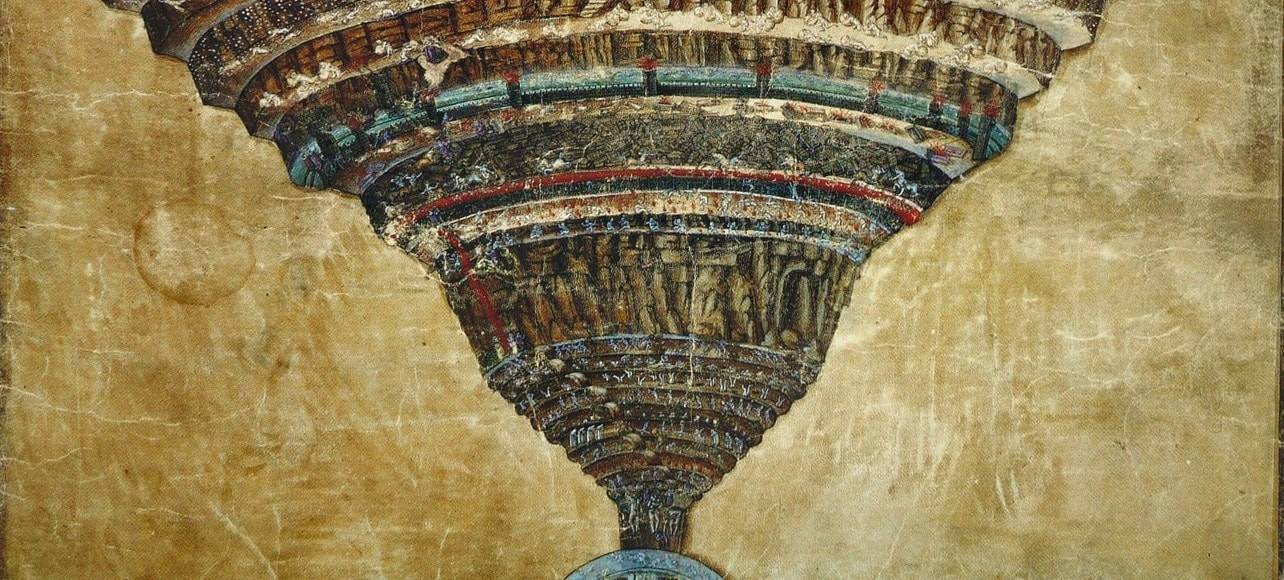Dante’s Inferno in One Incredible Interactive Map
One of literature’s most famous topographies makes for an incredible virtual graphic...
“It’s not down on any map; true places never are.” Thus wrote Melville in Moby Dick when referring to the island of Rokovoko —a land “far away to the West and South.” The fact is that the existence of any place in the real world isn’t always related to its relevance and less still to its reality. Such is the case of the Hell drawn by Dante Alighieri in the Divine Comedy. Today, this terrible imaginary place exists within an entirely new space. It’s a virtual and interactive map laying out in detail all its regions, while presenting the people who inhabit each of them.
Since its inception, the Divine Comedy has stimulated the imaginations of artists who’ve tried to capture in images that which the Florentine poet had created using only his words. The first illustrations describing Dante’s Inferno in its entirety appeared in 1491, some 200 years after that part of the poem had been written (Dante composed it between 1304 and 1307). Works since made by Sandro Botticelli, Salvador Dalí, William Blake, Gustav Doré, Robert Rauschenberg, and by the great Moebius stand out among the many examples.
With the passage of time, Dante’s cartography has lost some of its fertility in the collective Western imagination. (Who today imagines hell as a descending spiral divided into sections based on the sins committed by each sections’ inhabitants?) But the poem, perhaps among the most important in the history of humankind, still encourages its own visualization and reconfiguration in generation after generation (even during one like our own, governed as it is by new technologies). One example is this fabulous interactive map.
Illustrated in its amusing way, as though it were a children’s book, this version of Dante’s Inferno includes its own instructions and, funny enough, seems designed for all ages. The raw violence of the poet’s descriptions, the naked bodies burned and mutilated, are replaced by a map that might even be considered funny. Created by the Italian design firm, Alpaca, along with the studio Molotro, and funded by the Dante Alighieri Society, its purpose is both playful and educational. It’s an ideal companion for those making their first approach to Dante and his Divine Comedy.
In a design that stands out for its simplicity and practicality, the map allows an exploration of the circles of this new hell and for meetings with those inside each circle, including all the most famous. The map offers an index of the names of inhabitants in each area and lists of passages from the text. These can direct you to specific places on the map as described in the poem. Finally, the map allows one to scroll in and out from specific areas to learn more about each.
Surprisingly, this chart doesn’t just give new meaning to a place which doesn’t exist and one which has been revisited for centuries. It also reminds us that it’s the responsibility of each new generation to appropriate the art that’s come before, both as a way of inserting ourselves (imaginatively and personally) into a tradition that will never cease to be quite completely configured.
Related Articles
Pictorial spiritism (a woman's drawings guided by a spirit)
There are numerous examples in the history of self-taught artists which suggest an interrogation of that which we take for granted within the universe of art. Such was the case with figures like
Astounding fairytale illustrations from Japan
Fairy tales tribal stories— are more than childish tales. Such fictions, the characters of which inhabit our earliest memories, aren’t just literary works with an aesthetic and pleasant purpose. They
A cinematic poem and an ode to water: its rhythms, shapes and textures
Here lies One Whose Name was writ in Water. - John Keats Without water the equation of life, at least life as we know it, would be impossible. A growing hypothesis holds that water, including the
Watch beauty unfold through science in this "ode to a flower" (video)
The study of the microscopic is one of the richest, most aesthetic methods of understanding the world. Lucky is the scientist who, upon seeing something beautiful, is able to see all of the tiny
To invent those we love or to see them as they are? Love in two of the movies' favorite scenes
So much has been said already, of “love” that it’s difficult to add anything, much less something new. It’s possible, though, perhaps because even if you try to pass through the sieve of all our
This app allows you to find and preserve ancient typographies
Most people, even those who are far removed from the world of design, are familiar with some type of typography and its ability to transform any text, help out dyslexics or stretch an eight page paper
The secrets of the mind-body connection
For decades medical research has recognized the existence of the placebo effect — in which the assumption that a medication will help produces actual physical improvements. In addition to this, a
The sea as infinite laboratory
Much of our thinking on the shape of the world and the universe derives from the way scientists and artists have approached these topics over time. Our fascination with the mysteries of the
Sharing and collaborating - natural movements of the creative being
We might sometimes think that artistic or creative activity is, in essence, individualistic. The Genesis of Judeo-Christian tradition portrays a God whose decision to create the world is as vehement
John Malkovich becomes David Lynch (and other characters)
John Malkovich and David Lynch are, respectively, the actor and film director who’ve implicitly or explicitly addressed the issues of identity and its porous barriers through numerous projects. Now










